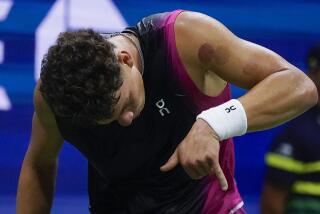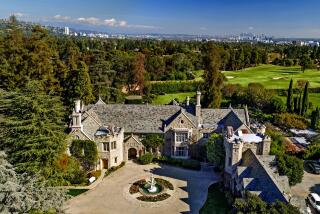For Sampras, It’s Par for the Course : U.S. Open: He runs Grand Slam record against golf partner Todd Martin to 4-0. Stich, Muster defeated.
- Share via
NEW YORK — Golf partners, sometime doubles partners, Davis Cup teammates and two players officially marketed as The Nice Guys of the men’s professional tour--Pete Sampras and Todd Martin--are so very different.
Sampras is No. 2 in the world, a winner of six Grand Slam tournament titles, and a high school dropout. Martin is No. 16, the winner of four tournaments in his entire career, and a former linguistics major at Northwestern University.
How Sampras’ lopsided victory on a tennis court could be so compelling may have more to say about a slow day in the quarterfinals of the U.S. Open than anything about the potential mystery as to who might win the match.
Sampras ran his record against Martin in Grand Slam tournaments to 4-0 with a 7-6 (7-4), 6-3, 6-4 victory.
Sampras anchored the night play and upstart Byron Black of Zimbabwe offered the day matches’ biggest upset. The 70th-ranked Black shocked the eighth-ranked Michael Stich, 6-4, 6-4, 3-6, 2-6, 6-3.
Little was known about Black, but after Tuesday’s match interesting facts emerged about his feet, which, we were told, have high arches.
It’s a footwear thing in Southern Africa: Zola Budd grew up running barefoot, as did thousands of lesser fortunate South Africans. Black grew up playing tennis on his father’s grass court, barefoot. He says it’s because he liked it, but the real story may be that his father, Donald, didn’t like the way tennis shoes chewed up his beloved courts.
Black has since become fully shod, and has been let loose on the tennis tour with an unusual two-handed forehand and backhand. The 25-year-old is better known as a doubles player and has taken a circuitous route to the semifinals of the U.S. Open. He’s gone from a farm outside of Harare, Zimbabwe, to John Newcombe’s Tennis Academy outside of San Antonio, to USC, where he led the Trojans to the national title in 1991.
Black was barely noticed outside of Africa until he won a few breakthrough events and applied to several schools before being noticed by USC.
“At the time, USC was the top-ranked tennis school in the nation,” he said. “I remember they were 32-0 going into the NCAA [championships]. That is the kind of school I dreamed of when I was in Zimbabwe. I never thought I would have a chance to go there.
Black’s love of tennis was nourished by his father, who played at Wimbledon in the 50s then came back to his 235-acre ranch where he raised avocados and personally put in four grass courts on his property. His three children, who are currently the highest-ranked tennis players in Zimbabwe, used the courts, all without shoes.
Thomas Muster’s feet, so happy on clay, were scorching dogs at the end of his match against Jim Courier. The French Open champion received treatment from a trainer for blisters during his match, which he lost. Courier, seeded No. 14, upset the third-seeded Muster, 6-3, 6-0, 7-6 (7-4).
The match featured two of the tour’s most chronically out-of-sorts players. Muster growls, Courier barks, and not even victories manage to perk up either man.
Muster, who is thought to be the most fit player around, looked tired and said he had used all his reserves of energy and emotion in his first three matches.
“There was nothing left today,” he said.
Courier, the former No. 1, said he is feeling good about his game and has no complaints about being ranked No. 15.
“I think the ranking reflects how I have played the last year, no doubt,” he said. “I think on good days, I am a much better player than my ranking reflects, but now, I have to parlay that into some better results along the way.”
The other quarterfinal match was won by Michael Chang, who defeated Michael Tebbett of Australia, 6-2, 6-2, 4-6, 6-3.
More to Read
Go beyond the scoreboard
Get the latest on L.A.'s teams in the daily Sports Report newsletter.
You may occasionally receive promotional content from the Los Angeles Times.











